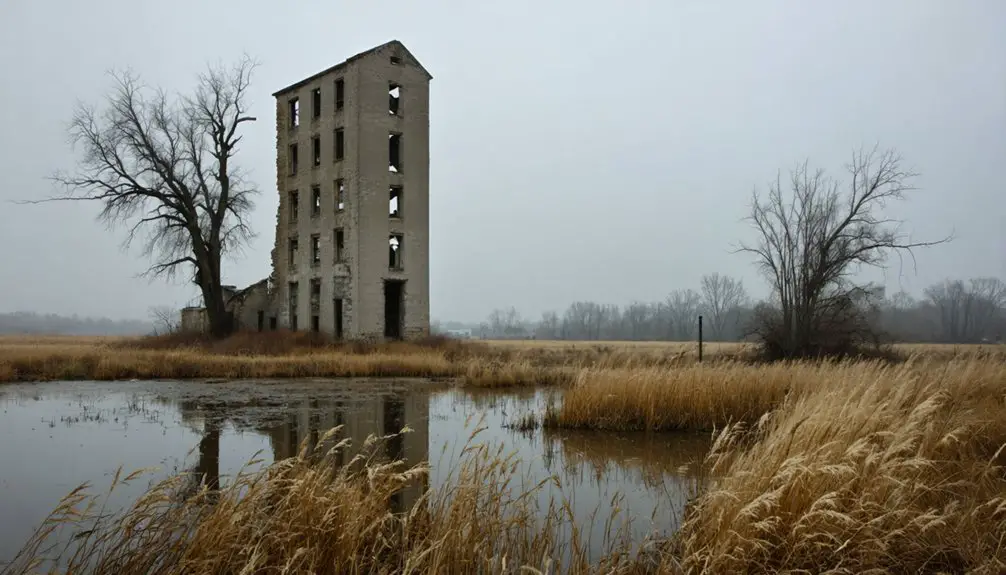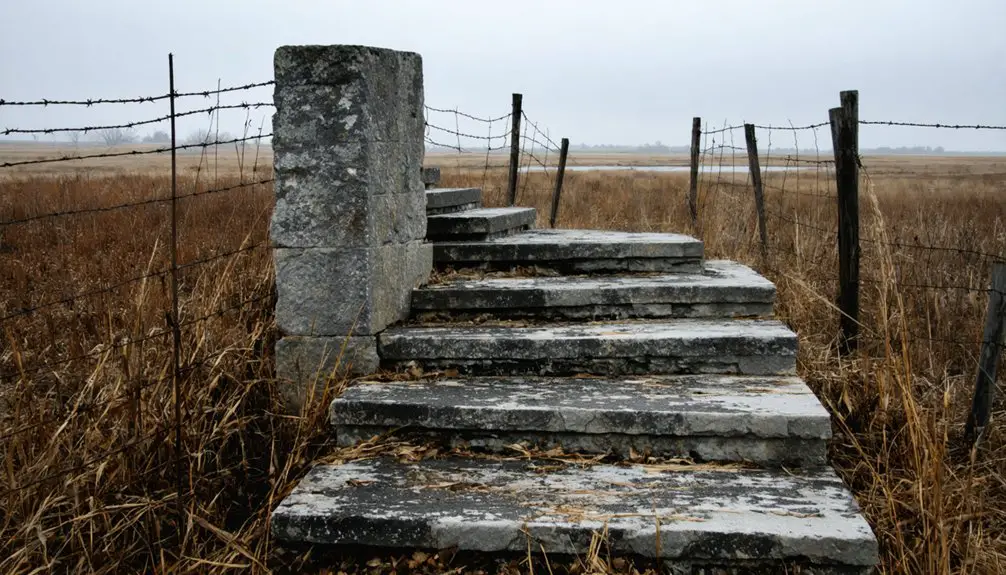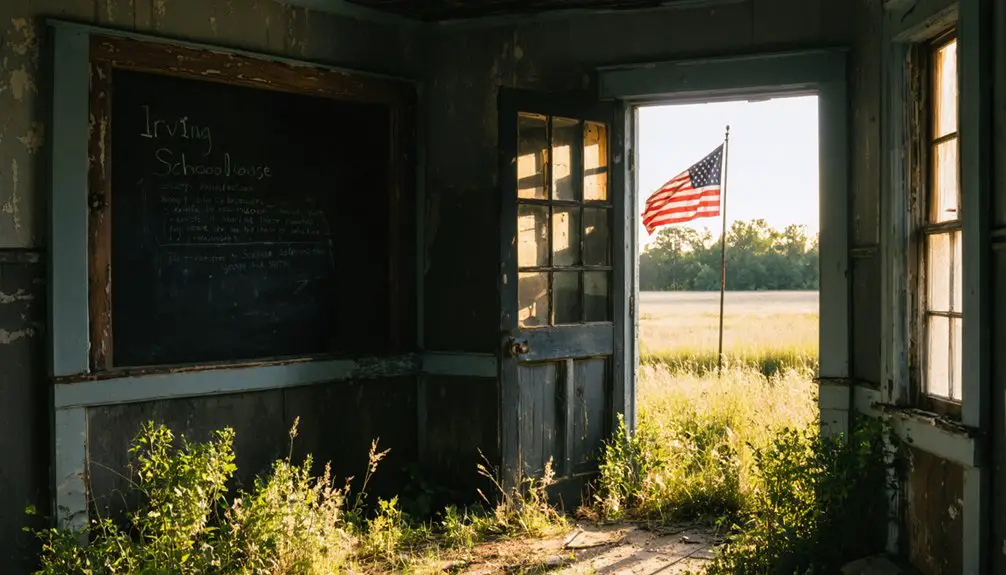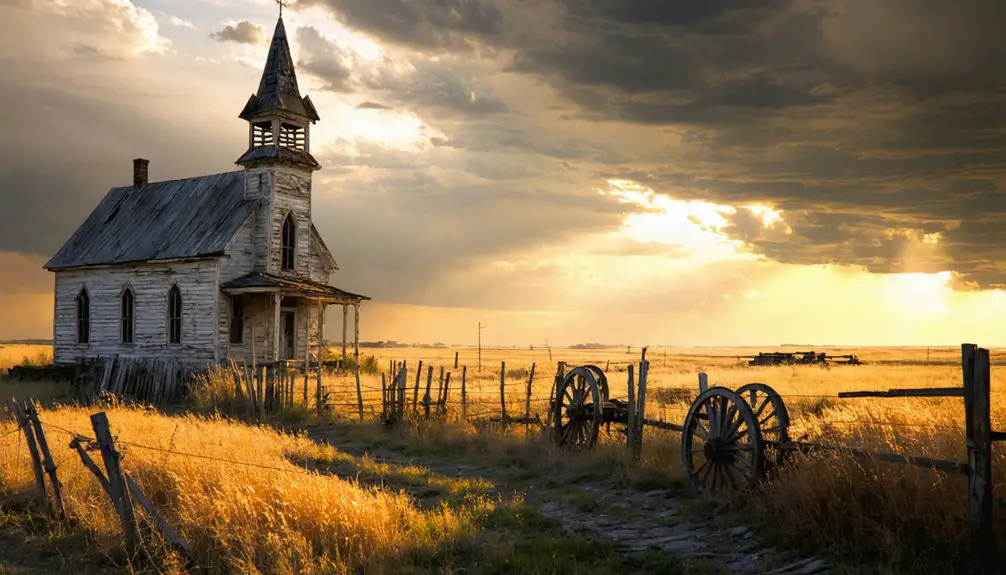You’ll find Irving’s ghost town ruins west of the Big Blue River in Kansas, where ten ambitious settlers founded an anti-slavery community in 1859. The town flourished until devastating natural disasters struck, including the infamous twin tornadoes of 1879 that killed 19 residents. Despite reaching 403 residents by 1910, recurring floods and the later construction of Tuttle Creek Dam sealed its fate. Today, a monument marks this tribute to pioneer resilience, where three annual gatherings keep its remarkable story alive.
Key Takeaways
- Irving was founded in 1859 in Kansas as an anti-slavery settlement, growing to over 400 residents before becoming a ghost town.
- Twin tornadoes struck in 1879, killing 19 residents and destroying the town, inspiring elements of “The Wonderful Wizard of Oz.”
- Multiple natural disasters, including floods, droughts, and grasshopper plagues, contributed to the town’s eventual abandonment.
- The construction of Tuttle Creek Dam in 1960 marked the final decline of Irving, with the site now serving as a wildlife refuge.
- A monument marks the former town’s location, where three annual gatherings celebrate Irving’s legacy and connect former residents’ descendants.
The Pioneer Vision of 1859
When ten ambitious settlers from Lyon City, Iowa joined forces in August 1859, they set their sights on establishing a progressive town in Kansas Territory.
You’ll find their pioneer dreams reflected in the diverse group of founders – lawyers, doctors, merchants, a teacher, a preacher, and a hotel keeper – who shared a vision of creating an anti-slavery community in the promising frontier.
Under the guidance of W.W. Jerome and abolitionist leader General Samuel C. Pomeroy, they selected a scenic tract west of the Big Blue River.
Despite settlement challenges, the group commenced by rail to St. Joseph, Missouri, then pressed on by mule team to their chosen site.
They named their new settlement Irving, honoring Washington Irving, whose writings had captured the spirit of the Northwest prairies they now called home.
The settlers quickly constructed their first building, a hewn log hotel, which would serve as both lodging and a gathering place for the community.
The town’s early growth was hindered when a severe drought struck in 1860, testing the resolve of the pioneering settlers.
Nature’s Wrath Against a Young Settlement
You’ll find Irving’s early history marked by nature’s relentless assault, beginning with devastating droughts and windstorms in the 1860s that forced some settlers to abandon their holdings.
Despite having over 400 residents and numerous thriving businesses in its prime, the town proved vulnerable to natural calamities.
The town’s struggles intensified when massive grasshopper swarms descended in 1866 and 1875, consuming every crop and tree leaf in their path. Like the diverse ecosystems found in modern conservation areas, the region once supported abundant plant life before these devastating events.
The culmination of these natural disasters came on May 30, 1879, when twin tornadoes struck from the west, destroying most of the town and claiming 19 lives.
Devastating Tornadoes Strike Irving
On May 30, 1879, two massive tornadoes struck Irving, Kansas within an hour of each other, killing 19 residents and over 60 people total along their paths.
The unprecedented double strike devastated the young farming community of 300 residents, leveling homes, businesses, and farms. Despite seeking shelter in cellars and dugouts, many victims were swept away, buried in mud, or driven into the ground by the violent winds. Despite the destruction, Irving showed resilience as the community regained agricultural prominence after rebuilding.
The tornado aftermath brought national attention, earning Kansas the nickname “The Cyclone State.” Among the victims were six Gale family members who perished in the disaster.
Weather bureau Sgt. J.P. Finley’s thorough documentation of the disaster laid groundwork for future tornado research. The storms’ impact on storm preparedness extended beyond Irving, influencing both scientific understanding and cultural memory, including inspiration for L. Frank Baum’s “The Wonderful Wizard of Oz.”
Grasshoppers Destroy Local Crops
Beyond the devastating tornadoes, Irving’s early settlers faced another destructive force of nature: recurring grasshopper plagues. You’d have witnessed swarms so massive they darkened the sky, particularly during the infamous 1866 invasion that struck your fledgling community. These insects devoured everything green in sight, from crops to tree bark. The damage was catastrophic, with settlers reporting drifts a foot deep against fence lines.
The agricultural collapse reached its peak in 1874 when the largest recorded swarm – stretching 1,800 miles long and 110 miles wide – descended upon the region. Your attempts to fight back would’ve proven futile, as burning, shooting, and trenching couldn’t stop the grasshopper devastation. Governor Thomas Osborn mobilized state resources to provide emergency relief.
The insects stayed for about a week, leaving behind contaminated water, inedible livestock, and discolored chicken eggs. With crops destroyed and food sources compromised, Irving’s pioneer families faced potential ruin from these relentless invaders.
Resilient Spirit of the Townspeople
Throughout Irving’s tumultuous history, the townspeople demonstrated remarkable resilience in the face of devastating natural disasters and economic challenges.
You’ll find their community resilience evident in how they rebuilt after each setback – from the severe drought of 1860 to the destructive windstorms that damaged their mills. When grasshopper plagues struck in 1866 and 1875, they persevered and maintained their agricultural livelihood.
Their historical perseverance shone brightest after the devastating 1879 tornadoes, when they reconstructed their schoolhouse and continued local governance despite losing 19 community members.
Even when facing the Big Blue River flood of 1903, they responded by improving flood defenses by 1908. The town’s population grew to 403 by 1910, proving their unwavering determination to thrive against all odds.
Native American Heritage and Local Legends
While Native American tribes like the Kaw and Osage shaped the cultural landscape around Irving long before settlers arrived, no definitive evidence exists of sacred sites directly within the town’s boundaries.
You’ll find that local folklore hints at possible Native ceremonies and rituals in the surrounding area, including accounts of a notable Kaw bonfire ceremony involving a captive.
Despite popular speculation about Native American curses affecting Irving’s later misfortunes, historical records don’t support these claims, as the region’s indigenous influences were primarily tied to broader patterns of migration and displacement rather than supernatural elements. The Native communities in this region experienced significant changes after European contact and diseases devastated their populations. The area would later see many immigrants seeking isolation, with numerous families from Pennsylvania Colony establishing new settlements.
Ancient Tribal Sacred Sites
Before Irving’s establishment in 1859, the region served as hallowed ground for the Kaws (Kansa) tribe, who performed significant spiritual ceremonies and warfare rituals in the area.
You’ll find evidence of their sacred rituals in the surrounding landscape, particularly at sites like the Penokee Stone Man, a 60-foot limestone figure that likely held religious significance for nomadic tribes.
The area’s tribal significance extends beyond the Kaws, as demonstrated by earthworks like the Serpent Mound in Rice County.
These sacred landscapes, created approximately 600 years ago by Wichita ancestors, stand as proof of the region’s rich Native American heritage.
Though many of these sites now rest on private land with limited access, they remain revered symbols of indigenous spiritual and cultural expression.
Mysterious Curse Origins
The legends of Native American curses often swirl around ghost towns across America, but Irving’s story offers a different perspective.
While you’ll find documented interactions between settlers and the Kaw tribe in the area, any curse history remains significantly absent from local records and oral traditions.
A folklore analysis reveals that Irving’s hardships – from devastating droughts to relentless grasshopper invasions – stemmed from natural causes rather than supernatural origins.
Unlike other ghost towns that embrace tales of ancient curses, Irving’s story is remarkably straightforward.
Despite the significant Native American presence in the region, particularly the Kaws, there’s no evidence of cursed sacred grounds or vengeful spiritual proclamations.
The town’s eventual demise came not from mystical forces, but from the very real impact of Tuttle Creek Lake’s construction.
The Big Blue River’s Fury and Impact

Raging waters from the Big Blue River released devastating floods on Irving throughout its history, with the 1903 flood marking a pivotal moment in the town’s decline.
You’ll find that these flooding events repeatedly battered Irving’s infrastructure, washing away homes and bridges while steadily eroding the town’s resilience.
The economic decline accelerated as the waters kept returning, weakening Irving’s foundations before a series of fires in the early 1900s dealt additional blows.
While the construction of Tuttle Creek Dam in 1960 finally tamed the Big Blue River’s fury, this victory came too late for Irving.
Today, you can still walk among the remnants of streets and building foundations in what’s now largely a ghost town and wildlife refuge – silent reminders of nature’s overwhelming power.
Commerce and Daily Life in Early Irving
Founded in 1859, Irving quickly blossomed into a vibrant commercial hub where daily life pulsed through its bustling streets long before the Big Blue River’s destruction.
You’d find local businesses thriving everywhere – from C.A. Mongomery’s and E.M. Petersen’s general stores to J.C. Moore’s grocery and boot shop. By 1917, the town buzzed with three merchandise stores, a bank, lumber company, and various specialty shops.
Daily routines centered around the town’s three churches, public school, and two lodges. You could catch up on local news at the printing office, make calls through the Irving Telephone Company, or visit one of two physicians.
Small-town life in Irving revolved around faith, education and community, with churches, schools and lodges bringing townsfolk together daily.
The limestone quarries kept the economy strong, while hotels, saloons, and the railroad station welcomed travelers passing through this promising Kansas settlement.
The Tuttle Creek Dam Controversy

The dam construction brought massive community displacement, requiring the government to negotiate with 1,713 landowners over 13 years.
You’ll find that ten Kansas communities faced disruption, with Irving being particularly affected. Though the lake would be miles away, Irving’s population declined sharply after the announcement, leading to its post office closure and abandonment by 1960.
Despite Congressman Howard Miller’s temporary halt to funding in 1955, Congress restored the money.
The $175 million project proceeded, forever transforming the Blue River Valley and its communities.
Tornados and Tales of Dorothy Gale
You’ll find that Irving’s most devastating event occurred on May 30, 1879, when twin tornadoes struck the town, killing 19 residents and destroying most buildings in their quarter-mile-wide path.
The town’s tragic tornado history has become intertwined with L. Frank Baum’s tale of Dorothy Gale in The Wizard of Oz, as both share the quintessential Kansas setting and the powerful imagery of destructive prairie storms.
While Irving eventually became a ghost town due to other factors, its tornado legacy lives on through local folklore and its cultural connection to Dorothy’s fictional journey to Oz.
Twin Tornadoes Strike Irving
On May 30, 1879, twin F4-F5 tornadoes struck Irving, Kansas within minutes of each other, devastating the small town and killing 19 residents while injuring 50 more.
The unprecedented twin vortexes emerged from two separate storm systems near five creek sources in Riley County. You’d have witnessed dark clouds forming suddenly from the southwest and northwest around 4 p.m., followed by powerful winds that destroyed small trees and fences before the main impact.
The tornado aftermath left Irving in ruins, with 34 homes leveled and most of the business district destroyed.
The second tornado, nearly two miles wide, stripped pavement from highways and hurled a 120,000-pound water tank several blocks. This historic event marked the first documented case of dual tornadoes hitting a single town in one day.
Dorothy’s Kansas Connection
While L. Frank Baum crafted Dorothy Gale’s character from Kansas’s essence, you’ll find her story deeply intertwined with Irving’s tragic 1879 twin tornadoes.
Dorothy’s symbolism reflects the resilient spirit of Kansas prairie life, where tornados weren’t just weather events but transformative forces that shaped communities. You’ll recognize how the Irving disaster, killing 19 people, influenced tornado folklore that later emerged in The Wizard of Oz.
The real-life backdrop of Kansas’s tornado-prone landscape, averaging one to three EF3+ tornadoes per county since 1950, mirrors Dorothy’s fictional world.
Her tale captures the duality of Kansas tornado folklore – both destructive and magical – preserving the cultural memory of towns like Irving, where natural disasters became catalysts for extraordinary narratives of survival and change.
Local Legend Lives On
Today, Irving’s legendary twin tornadoes of 1879 remain deeply woven into Kansas’s cultural fabric, spawning tales that continue to captivate locals and historians alike.
You’ll find tornado folklore intertwined with the region’s identity, particularly through connections to Dorothy Gale’s fictional journey in “The Wizard of Oz.” The devastating F4 tornado that claimed 60 lives has become a powerful symbol of community resilience, as survivors’ stories passed down through generations tell of both tragedy and triumph.
While Irving eventually became a ghost town, its tornado legacy endures through local narratives of destruction and rebuilding.
The twin tornadoes’ impact extends beyond mere historical record – they’ve shaped Kansas’s collective memory and influenced modern approaches to severe weather preparedness throughout the state.
Preserving Irving’s Physical Remnants
Despite the flooding of Tuttle Creek Lake that displaced many nearby communities, Irving’s physical remnants still stand as visible markers of the former town’s existence.
You’ll find foundations of old buildings and the original street network clearly visible at the site, allowing you to walk through the town’s footprint. Site accessibility remains open to the public, with a stone marker and visitor mailbox at the intersection of Zenith and 12th Roads.
Community involvement keeps Irving’s physical legacy alive through annual gatherings near the monument, while the Blue Rapids Museum preserves artifacts and photographs.
Though natural disasters and time have taken their toll on the structures, dedicated local residents and descendants continue maintaining what remains. The site now serves as a wildlife refuge, which helps protect these historic remnants from development.
Ghost Town Legacy and Annual Remembrance

Three annual traditions keep Irving’s memory alive through community gatherings at the monument where the post office once stood.
These historical significance events draw former residents and their descendants, preserving the spirit of this remarkable Kansas settlement.
When you visit the Irving monument today, you’ll discover how the community maintains its connections through:
- Annual picnics that reunite families with ties to the original town
- Memorial gatherings that honor those who endured natural disasters
- Historical preservation events that share stories of Irving’s resilience
- Educational tours exploring the remaining street layouts
You can still walk the paths where Irving’s residents once lived, connecting with a legacy that spans from its 1859 founding through multiple rebuildings, until the Tuttle Creek Dam project finally ended this resilient community’s physical presence.
Frequently Asked Questions
What Was the Highest Recorded Population of Irving During Its Peak Years?
Like a bustling beehive at its prime, you’d find Irving’s highest population reached 403 residents in 1910, during its peak years when the town thrived with businesses and community services.
Did Any Famous Personalities Besides Washington Irving Have Connections to the Town?
You’ll find only two notable historical figures connected to Irving: Senator Samuel C. Pomeroy, who helped establish the town, and L. Frank Baum, who reportedly drew inspiration for Dorothy Gale from local tornado stories.
What Specific Crops Were Primarily Grown by Irving’s Farming Community?
With 80% of local farms dedicated to grain production, you’d find wheat farming dominated Irving’s agricultural landscape, while corn production served as another vital crop for the community’s sustenance.
Were There Any Schools or Churches Established in Irving Before Abandonment?
You’ll find significant school history in Irving’s stone schoolhouse from 1868, later rebuilt structures, and the Wetmore Institute. The town’s church significance included multiple churches, with the first completed in 1861.
How Many Original Buildings or Structures From Irving Still Stand Today?
You’ll find no fully preserved structures of architectural significance standing today, though historical preservation efforts highlight building foundations, old sidewalks, and a lone stone marker denoting the former post office location.
References
- http://www.lovewellhistory.com/blog/theres-no-place-like-irving.html
- https://en.wikipedia.org/wiki/Irving
- https://www.romeoriders.com/forums/viewtopic.php?t=156
- https://legendsofkansas.com/irving-kansas/
- https://kids.kiddle.co/Irving
- https://lostkansas.ccrsdigitalprojects.com/sites/lostkansas/files/private_static/2023-06/LT_MS_Irving_Allen.pdf
- https://digitalcommons.unl.edu/cgi/viewcontent.cgi?article=3612&context=greatplainsquarterly
- https://www.cityviewnc.com/stories/lyman-baum-the-book-of-failure-and-a-prairie-disaster/
- https://shows.acast.com/this-date-in-weather-history/episodes/1879-the-real-life-inspiration-for-the-wizard-of-oz
- http://www.kansas.net/~rjherman/Irving



